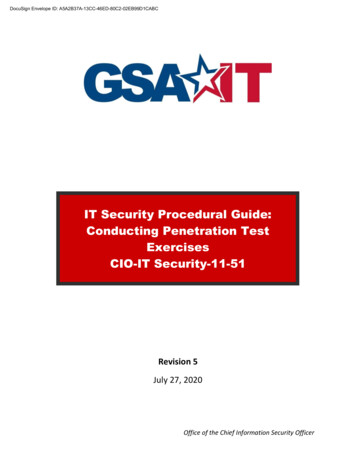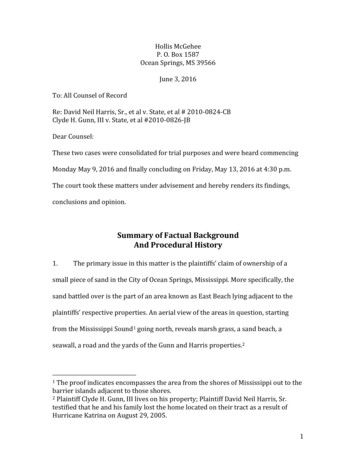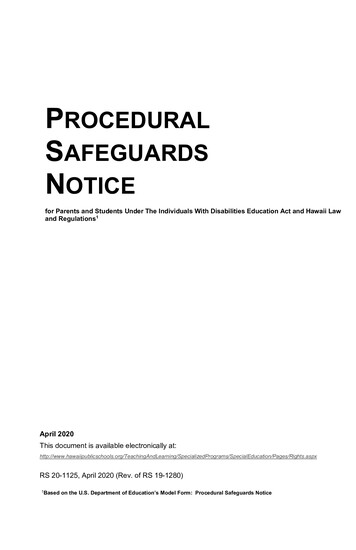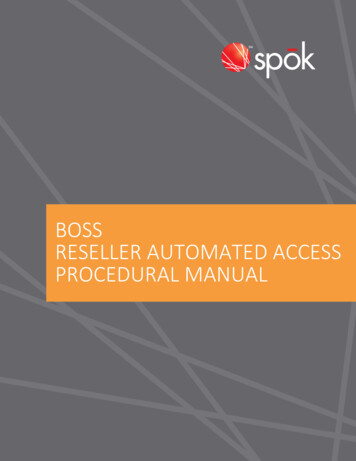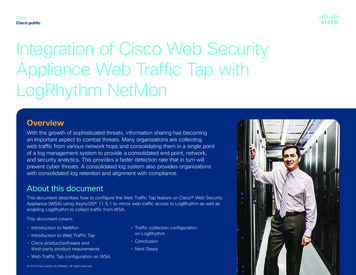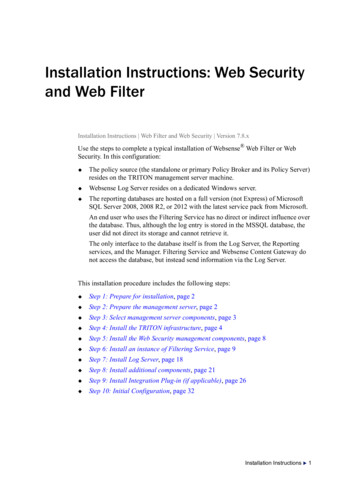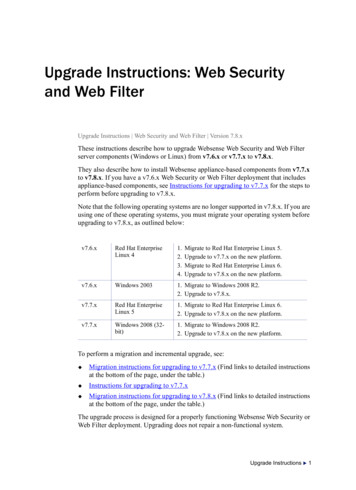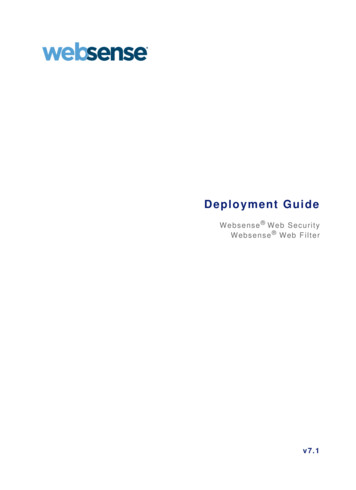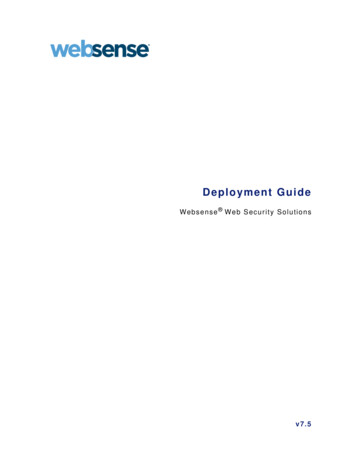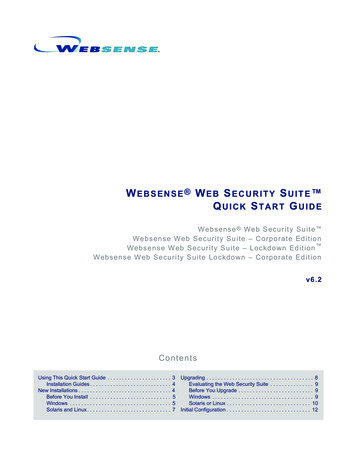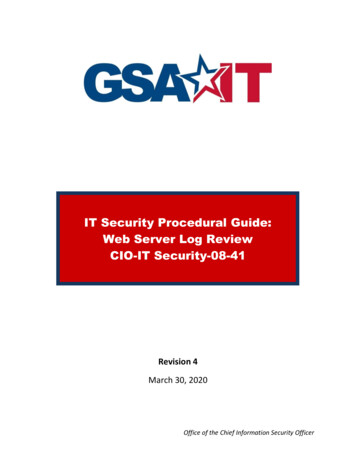
Transcription
IT Security Procedural Guide:Web Server Log ReviewCIO-IT Security-08-41Revision 4March 30, 2020Office of the Chief Information Security Officer
CIO-IT Security-08-41, Revision 4Web Server Log ReviewVERSION HISTORY/CHANGE ing1Bo Berlas/WilliamSalamonRon Wilson212ChangeRevision 1 April 1, 2015Changes made throughout thedocument to reflect FISMA, NIST andGSA CIO P 2100.1 requirements.Revision 2 – April 7, 2016Extensive changesVarious formatting and contentchanges.Revision 3 – March 13, 2018Minor changesWilliamSalamon1LambardoUpdated to reflect and implementvarious FISMA, NIST and GSA CIO P2100.1 requirements.Evolving threat landscapePageNumber ofChangeVariousNumerousShareholder comments.VariousScheduled update.VariousVariousUpdates to clarify proceduresIncorporate most current Federalregulations, NIST guidance, and GSArequirements.Feedback from stakeholdersRevision 4 – March 30, 2020Minor changesScheduled update.VariousWilliamSalamonBryon Feliksa Updated format, structure, Federalregulations, and guidance.3Reason for ChangeU.S. General Services AdministrationVarious
CIO-IT Security-08-41, Revision 4Web Server Log ReviewApprovalIT Security Procedural Guide: Web Server Log Review, CIO-IT Security-08-41, Revision 4 ishereby approved for distribution.XBo BerlasGSA Chief Information Security OfficerContact: GSA Office of the Chief Information Security Officer (OCISO), Security Engineering Division(ISE) at SecEng@gsa.gov.U.S. General Services Administration
CIO-IT Security-08-41, Revision 4Web Server Log ReviewTable of Contents1Introduction.11.11.21.32Overview .4.42.4.53Purpose . 1Scope . 1References . 2Summary Views . 3Detailed Views . 5Format .5Apache Logs .5Microsoft IIS Logs .6Abnormal Logs .7Log Inspection Methodology . 9Suspicious Content . 10Authentication .11Directory Breakout.11Active Code/JavaScript .11SQL Injection .12Miscellaneous .12Summary . 12Appendix A: Log Analysis Tools. 14Appendix B: ASCII Table . 17Appendix C: Points of Contact . 19Table of Figures and TablesFigure 2-1: Microsoft IIS Web Server .6Figure 2-2: IIS Log .7Figure 2-3: IIS Log Format .7Figure A-1: Splunk . 15Figure A-2: Web Log Explorer . 16Table B-1: ACSII Table - Non-Printable Characters . 17Table B-2: ASCII Table - Printable Characters . 18U.S. General Services Administrationi
CIO-IT Security-08-41, Revision 41Web Server Log ReviewIntroductionWeb applications are critical to both the mission and the defense of the enterprise. By nature,web servers provide services directly to users over the HTTP and HTTPS services ports 80, 8080,and/or 443. Depending upon the application, servers accept requests from within GeneralServices Administration (GSA) networks or from external internet users. Full-featured webapplications are often connected to databases that may store sensitive information. Thecombination of accessibility and high value data present a rich target for attackers. Most usersaccess web services using a standard browser, but attackers can use a variety of custom tools tosend carefully crafted requests designed to break the server and its security defenses. Althoughsecurity technology and web server configuration provide some protection for web servers,routine monitoring of these defenses is essential. This guide outlines some simple steps to helpa reviewer parse through web server logs and understand what signs to look for during theirreview.Regular review of web logs has many benefits to the management of both the security of webresources and system performance. When a network is experiencing slowdowns or otheranomalies, log data can help provide insights into the cause of the problem. A large amount ofuseful data is generated in the form of web server logs. Because of the volume, format andcomplexity of logs, it is often difficult to obtain actionable knowledge from web server logs.For additional information and guidance, please contact the appropriate security staff in theOffice of the Chief Information Security Officer (OCISO) as identified in Appendix C.1.1 PurposeThis guide is designed to provide an overview of how to conduct periodic web server log reviewthat is integral to web system operation and security oversight. It does not address the specificneeds of Enterprise-wide log analysis systems that aggregate logs from many servers. The guidediscusses summary and detailed views of log content. It describes the common formats ofApache and Microsoft Internet Information Services (IIS) web log entries. It proposes amethodology for the task of reviewing logs for malicious or suspicious activity. Appendicespoint the reader to further information, software for summary log inspection, and an ASCIItable to decode hexadecimal that can sometimes be found in headers.1.2 ScopeAll GSA employees and contractors with Information Technology (IT) and/or IT Security (IS)responsibilities including but not limited to GSA Operations Staff and Information SystemSecurity Officers (ISSOs) tasked with reviewing web server logs of isolated systems that mayhave evidence of security events, must become familiar with this guide. While the informationpresented may be informative for Enterprise log review, it does not address the correlation ofevents that is an important part of Enterprise log analysis tools. It does not address non-weblogs that are generated by operating systems and database management systems.U.S. General Services Administration1
CIO-IT Security-08-41, Revision 4Web Server Log Review1.3 ReferencesNote: GSA updates its IT security policies and procedural guides on independent biennial cycleswhich may introduce conflicting guidance until revised guides are developed. In addition, manyof the references listed are updated by external organizations which can lead to inconsistencieswith GSA policies and guides. When conflicts or inconsistencies are noticed, please contactispcompliance@gsa.gov for guidance.The following references provide guidance, tools, and additional information on the subject oflog reviews.Federal Guidance: Federal Information Processing Standards (FIPS) Publication (PUB) 199, “Standards forSecurity Categorization of Federal Information and Information Systems”National Institute of Standards and Technology (NIST) Special Publication (SP) 800-53,Revision 4, “Security and Privacy Controls for Federal Information Systems andOrganizations”NIST SP 800-92, “Guide to Computer Security Log Management”NIST SP 800-95, “Guide to Secure Web Services”GSA Guidance: GSA Order CIO 2100.1, “GSA Information Technology (IT) Security Policy”The guidance documents below are available on the GSA IT Security Procedural GuidesInSite page. CIO-IT Security-01-02, “Incident Response (IR)”CIO-IT Security-01-08, “Audit and Accountability”Additional Resources: 2Microsoft - Internet Information Services (IIS) 10SANS - Top 5 Essential Log ReportsSANS - Critical Log Review Checklist for Security IncidentsHTTP Status Code DefinitionsOpen Web Application Security Project (OWASP) GuidanceTenable NessusSplunkAWStatsWebLog ExpertOverviewThere are two aspects to web server log inspection. The first involves reviewing summaryinformation that records general trends. This review leverages log analysis tools that can sortlog data and provide various summary views. The summaries should group data from theU.S. General Services Administration2
CIO-IT Security-08-41, Revision 4Web Server Log Reviewreview period in order to highlight unusual events. By providing many different views of the logdata, a good analysis tool increases the likelihood anomalies will be noticed.The second aspect of web server log review is the detailed inspection of one or more logentries. This requires detailed knowledge of the log format and the meaning of each field. Webserver log entries are often cryptic and familiarity with both the log format of the specific webserver and the ways in which malicious misuse presents itself is critical.In both cases the most valuable knowledge is gained through frequent inspection which shouldhappen at least weekly. Weekly inspections should involve the comparison of summaryinformation with summaries from previous periods. Similarly, detailed log entries should bechecked regularly with the objective of becoming familiar with normal entries, furtherenhancing the ability to identify inappropriate or unusual activity.Systems that have been designated as FIPS 199, “Standards for Security Categorization ofFederal Information and Information Systems” Moderate or High Impact are subject tocontinuous monitoring. Continuous monitoring does not imply true, real-time 24x7, non-stopmonitoring and reporting. Instead, it means implementing monitoring and oversight processesthat provide a clear picture of security state at a given time, while also providing a mirror ofcontrol effectiveness over time.Automated log reviews can be set to occur on a reoccurring basis, such as every 5, 10 or 15minutes; every hour or every day; and log data can be collected from the central manager atregular intervals. Information needed to monitor critical data, as well as the data processingresources and their controls, should be continuously collected. System administrators and/orsecurity engineers must inspect the output of these tools at least weekly. However, the logsshould be reviewed more frequently if the risk to the information and computing resourcesmake it necessary. Some security events may require immediate action. For example, anyunauthorized changes to system configuration must be reported in near real-time andcorroborated with other system information to check for authorization.GSA IT Security Procedural Guide: CIO-IT Security-01-08, “Audit and Accountability” containsspecific control requirements regarding auditing/logging from NIST SP 800-53, Revision 4,“Security and Privacy Controls for Federal Information Systems and Organizations.” Foradditional information and guidance, refer to Appendix C for contact information.2.1 Summary ViewsA summary of the logs gives the reviewer a high-level view (in graphical or other condensedform) of an otherwise large, complex and confusing dataset. The most common viewsgraphically plot some attribute over time. With enough attributes, these graphs could help todiscern that a particular type of event may or may not be considered a normal/non-ominousoccurrence at a particular time. An example of this might be the number of bytes sent. Byplotting this against time, it could be obvious that a one-time, large transmission (e.g., 60U.S. General Services Administration3
CIO-IT Security-08-41, Revision 4Web Server Log ReviewMbytes) at 2:47 am on a Sunday morning might stand out as requiring an explanation, eventhough the same transmission might be perfectly normal at another time.Other views may be used to find correlations that are not apparent any other way. A web sitethat serves a fixed set of users (AR/AP, HR, etc.) may have very consistent use by users. Achange in the list of the Top 20 users or Top 20 web pages might indicate unusual activity thatshould be investigated.Threats come from both inside and outside the organization. External facing web servers shouldidentify where the users of the hosted web site are located. A large change in the country oforigin of requests might have significance to GSA or other Federal agencies.Below is a list of time slice views and Top 20 type views that might be useful.1. Time slice views (hour/day/week)a. Hitsb. Bandwidthc. HTTP “Method” (GET, PUT, etc.)d. Country of Sourcee. Average or total bytesf. Errors types2. Top 20’sa. Usersb. IP address of sourcec. Pages servedd. Entry Points3. Signature “hits” from corresponding network monitoring toolsa. Heuristic matchesb. Regular expression matchesc. SNORT (or other IDS) rule matchesThe above list is not exhaustive and should be adjusted depending on the type of server and theanalysis software used. Appendix A lists some log analysis software tools that can be used togenerate various summary views of web server log files.When reviewing the web logs from a particular server, it is often helpful to correlate the logentries against event logs generated by network tools such as application firewalls (e.g. PaloAlto) and intrusion detection systems (e.g., Security Onion). These network-based tools oftenassign risk scores to certain events or collection of events. By examining high-risk networkactivity to/from a particular web server, the analyst can focus on specific dates and times whenreviewing web logs from that server. The GSA Security Operations Division (ISO) maintains thenetwork security tools, including our Security Information and Event Manager (SIEM)[Enterprise Logging Platform (ELP)], GSA’s Security Onion instance, and Palo Alto devices. SeeAppendix C for ISO Division contact information.U.S. General Services Administration4
CIO-IT Security-08-41, Revision 4Web Server Log Review2.2 Detailed ViewsThe second way of inspecting web server logs is to look at the individual entries in the log andbecome familiar with what the different fields mean. Examination of the logs themselves can betedious unless the reviewer understands what is normal and what is not. The files tend to bevery large, so to help in this process the reviewer should learn the format of the logs fromhis/her servers and make the best use of search tools in detailed log inspection.2.2.1 FormatLogs have many different formats and viewing the raw logs can be challenging. However, thereare standard log formats for Apache and Microsoft IIS web servers that contain the same orsimilar information. Identifying the format can be tricky, but with a little research on theinternet and an hour or so of looking at log files, the pattern will become clear. To speed up thisprocess, an annotated description of log entry formats for both Apache and Microsoft IIS webserver logs are presented below. Please note that there is no single type of Apache or IIS webserver log entry, so this is useful only as an example, and not as a reference.2.2.2 Apache LogsApache log configuration is located in a file called “conf/httpd.conf” in the root apacheinstallation folder. Instructions for log configuration are embedded in the file. There are severallog format samples available in the configuration file.Below is a log entry in the Combined Log Format (CLF).127.0.0.1 - eric [10/Oct/2007:13:55:36 0700] "GET /index.html HTTP/1.0" 200 2326"http://www.example.com/eric.html" "Mozilla/4.0 (compatible; MSIE 7.0; Windows NT5.1; .NET CLR 1.1.4322)"This log entry can be parsed into the following fields:127.0.0.1: the IP address of the client“-“: The hyphen in the output indicates that the requested piece of information is notavailable. In this case, the information that is not available is the identity of the client.eric: This is the userid of the person requesting the document as determined by HTTPauthentication.[10/Oct/2007:13:55:36 0700]: The time that the server finished processing the request."GET /index.html HTTP/1.0": The request line from the client.200: This is the status code that the server sends back to the client.2326: This entry indicates the size of the object returned to the client, not including theresponse headers."http://www.example.com/eric.html": The referring webpage.U.S. General Services Administration5
CIO-IT Security-08-41, Revision 4Web Server Log Review"Mozilla/4.0 (compatible; MSIE 7.0; Windows NT 5.1; .NET CLR 1.1.4322)": The UserAgent HTTP request header.This is represented in some documentation as:LogFormat "%host %other %logname %time1 %methodurl %code %bytesd%refererquot %uaquot"There are various other formats for Apache logs as well. GSA IT recommends use of theCombined Log Format for Apache servers. There are additional capabilities that log the totalnumber of bytes received and transmitted in each request. This however is specific to theimplementation of Apache and should be modified only by the technical support engineers.2.2.3 Microsoft IIS LogsIIS logs are located in the “inetpub\logs\logfiles” directory. They are configured using the IISManager in the Administrative Tools pop-up menu via a file named “iis.msc.” The mostcomprehensive logging is available using the W3C Extended Log File Format. GSA ITrecommends using this format for Microsoft IIS Web Servers (See Figure 2-1).Figure 2-1: Microsoft IIS Web ServerU.S. General
This guide is designed to provide an overview of how to conduct periodic web server log review that is integral to web system operation and security oversight. It does not address the specific needs of Enterprise-wide log analysis systems that aggregate logs from many servers. The guide discusses su
